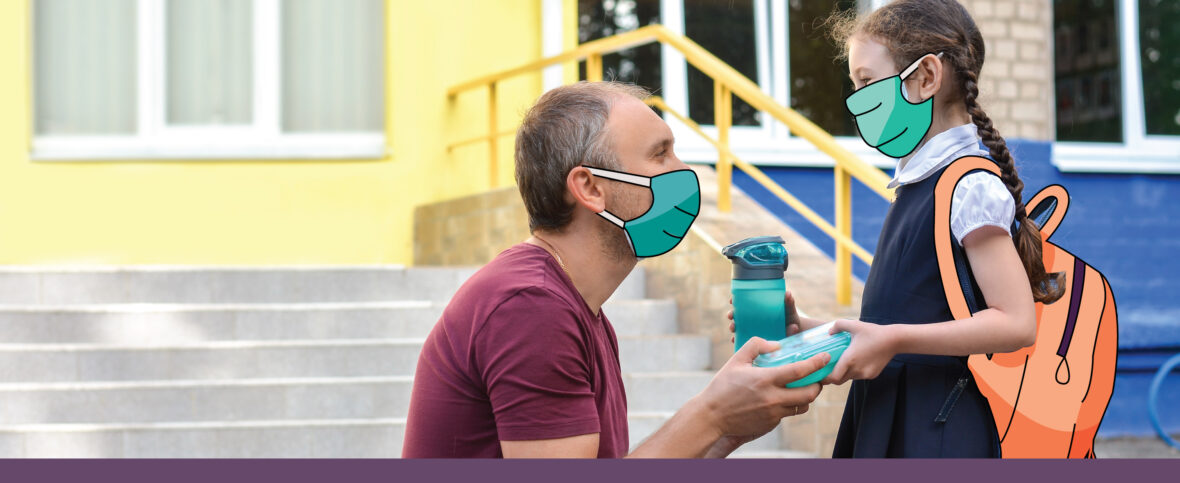See all > Parenthood

September 24, 2020 • read
What to know before sending your kids back to school
Parents across Canada have tough choices to make this September. Should they send their kids back to school amidst a global pandemic?
Happily, COVID-19 doesn’t seem to affect young people in the same way that it affects older adults. Children tend to have very mild symptoms, and most are completely asymptomatic. That’s also where the complication lies, since it means kids could have COVID-19 without showing outward signs. Even though kids tend not to get as sick, they can still spread the disease to more vulnerable people.
Public health guidelines are different from one community to the next, so it’s wise to check yours regularly. However, there are some general rules that parents can use to inform their decisions this fall. Here are some points to consider as you prepare for the upcoming school year.
Screen your children for symptoms daily
Make screening your child for COVID-19 symptoms a part of your daily routine. By looking for signs of illness each day, you’ll reduce the risk of sending a sick kid to school. Here are warning signs that a young person may have COVID-19:
- Fatigue
- Cough
- Trouble breathing
- Temperature at or over 38°C
- Chills
- Muscle pain
- Body aches
- Headache
- Gastrointestinal issues like stomach ache, diarrhea or vomiting
- Generally feeling unwell
For more information on what to consider for children of all ages when screening for COVID-19, consider these resources:
Maple COVID-19 resource centre
Health Canada – COVID-19 Symptoms and Treatment
Public Health Ontario: What we know so far about COVID-19 and children
Heath Canada – COVID-19 guidance for schools Kindergarten to Grade 12
Consider the health of everyone in your home
Sending your kids back to school ups the risk of infection for everyone in your household. Consider who in your household is particularly vulnerable to COVID-19. Factors that make people vulnerable to COVID-19 infection include:
- Lung disease
- High blood pressure
- Cancer
- Hypertension
- Diabetes.
- Weakened immune system
- Old age
Learn more about health conditions that make adults more vulnerable to contracting coronavirus here:
Health Canada – People who are at high risk for severe illness from COVID-19
CDC – Coronavirus Disease 2019 (COVID-19) – Older Adults
BC Centre for Disease Control – Vulnerable populations
Make time to talk about mental health
COVID-19 has affected everyone’s mental health, your kids included. For some kids, the structure of school provides a comforting routine. And, they’ll probably be over-the-moon to see their friends again. But every child is different, and it’s possible that your children are nervous about going to school in pandemic times. Make space for conversations about feelings and mental health this September. Kids can have a hard time articulating their feelings, so reading a storybook or sharing a fun activity can be good segues into vulnerable conversations.
Not sure how to begin talking to your kids about mental health during COVID-19? Start here:
CHEO – Back to School During COVID-19: Tips for Parents and Caregivers
About Kids Health – COVID-19 Learning Hub
Children’s Mental Health Centre – COVID-19 Resources
Montreal Children’s Hospital – How to support kids’ mental health during the COVID-19 pandemic
Mental Health Commission of Canada – External COVID-19 Resources: Children & Youth
Make wearing masks fun
Wearing masks is an adjustment for all of us. Making them a fun and normal part of the day will help your kids get used to wearing them, and seeing them on others. Here are a few ways to normalize wearing a mask with your kids:
- Wear them at home. Even if for short periods, putting on masks at home will help your kids get used to seeing adults with them on.
- Remind your kids their favourite superheroes wear masks too.
- Choose masks in your child’s favourite colour, or a fun pattern.
- Explain that the masks protect other kids and their families.
Not every school requires students to wear masks. Be sure to check your child’s school for their policy.
For tips on how to explain masks to kids and common questions kids ask, look here:
New York Times – Children May Be Afraid of Masks. Here’s How to Help
Kids Health – Coronavirus (COVID-19): Helping Kids Get Used to Masks
Lifespan – Wearing Face Masks and How to Explain It to Kids
Continue to socialize within your bubble
It’s all about the bubbles. Your bubble consists of yourself, your household members, and whichever select individuals you’ve agreed to socialize with. Yes, your children will be exposed to people outside of your bubble if they’re attending school. That doesn’t mean that adults should expand their bubbles too. In fact, the increased risk of exposure with back-to-school means we should exercise more caution. Limiting exposure could save lives, so maintaining your social bubble is a high priority.
Not sure how to form your contact bubble? Here are a few links to help you get started:
Healthing – Guideline confusion: Are you ‘bubbling’ or ‘social circling’?
CBC News – How many people can I see at once? Coronavirus social rules by region
Whether you’re sending kids to school or homeschooling this year, these guidelines are important for every caregiver to know. Each household plays a vital role in maintaining community health. The more kids and adults who adhere to best practices, the healthier each neighbourhood will be.
Looking for another way to support you and your family’s health? See a doctor online to take care of your family from kids to grandparents.
